火山喷发(volcanic eruption)
- 格式:ppt
- 大小:130.00 KB
- 文档页数:12
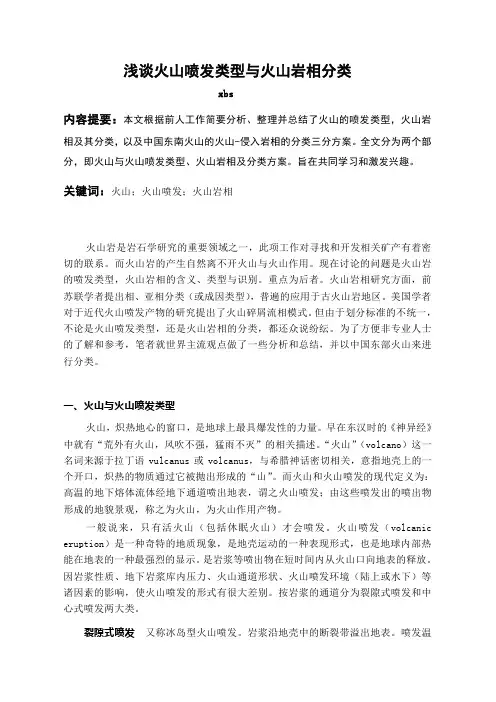
浅谈火山喷发类型与火山岩相分类xbs内容提要:本文根据前人工作简要分析、整理并总结了火山的喷发类型,火山岩相及其分类,以及中国东南火山的火山-侵入岩相的分类三分方案。
全文分为两个部分,即火山与火山喷发类型、火山岩相及分类方案。
旨在共同学习和激发兴趣。
关键词:火山;火山喷发;火山岩相火山岩是岩石学研究的重要领域之一,此项工作对寻找和开发相关矿产有着密切的联系。
而火山岩的产生自然离不开火山与火山作用。
现在讨论的问题是火山岩的喷发类型,火山岩相的含义、类型与识别。
重点为后者。
火山岩相研究方面,前苏联学者提出相、亚相分类(或成因类型),普遍的应用于古火山岩地区。
美国学者对于近代火山喷发产物的研究提出了火山碎屑流相模式。
但由于划分标准的不统一,不论是火山喷发类型,还是火山岩相的分类,都还众说纷纭。
为了方便非专业人士的了解和参考,笔者就世界主流观点做了一些分析和总结,并以中国东部火山来进行分类。
一、火山与火山喷发类型火山,炽热地心的窗口,是地球上最具爆发性的力量。
早在东汉时的《神异经》中就有“荒外有火山,风吹不强,猛雨不灭”的相关描述。
“火山”(volcano)这一名词来源于拉丁语vulcanus或volcanus,与希腊神话密切相关,意指地壳上的一个开口,炽热的物质通过它被抛出形成的“山”。
而火山和火山喷发的现代定义为:高温的地下熔体流体经地下通道喷出地表,谓之火山喷发;由这些喷发出的喷出物形成的地貌景观,称之为火山,为火山作用产物。
一般说来,只有活火山(包括休眠火山)才会喷发。
火山喷发(volcanic eruption)是一种奇特的地质现象,是地壳运动的一种表现形式,也是地球内部热能在地表的一种最强烈的显示。
是岩浆等喷出物在短时间内从火山口向地表的释放。
因岩浆性质、地下岩浆库内压力、火山通道形状、火山喷发环境(陆上或水下)等诸因素的影响,使火山喷发的形式有很大差别。
按岩浆的通道分为裂隙式喷发和中心式喷发两大类。
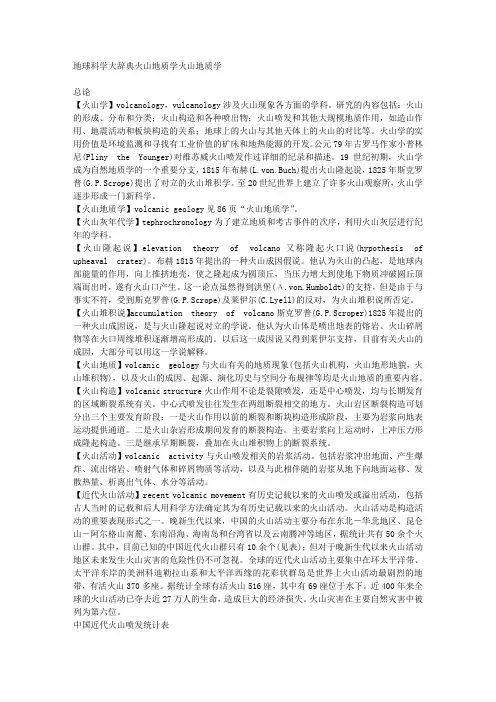
地球科学大辞典火山地质学火山地质学总论【火山学】volcanology,vulcanology涉及火山现象各方面的学科。
研究的内容包括:火山的形成、分布和分类;火山构造和各种喷出物;火山喷发和其他大规模地质作用,如造山作用、地震活动和板块构造的关系;地球上的火山与其他天体上的火山的对比等。
火山学的实用价值是环境监测和寻找有工业价值的矿床和地热能源的开发。
公元79年古罗马作家小普林尼(Pliny the Younger)对维苏威火山喷发作过详细的纪录和描述。
19世纪初期,火山学成为自然地质学的一个重要分支,1815年布赫(L.von.Buch)提出火山隆起说,1825年斯克罗普(G.P.Scrope)提出了对立的火山堆积学。
至20世纪世界上建立了许多火山观察所,火山学逐步形成一门新科学。
【火山地质学】volcanic geology见86页“火山地质学”。
【火山灰年代学】tephrochronology为了建立地质和考古事件的次序,利用火山灰层进行纪年的学科。
【火山隆起说】elevation theory of volcano又称隆起火口说(hypothesis of upheaval crater)。
布赫1815年提出的一种火山成因假说。
他认为火山的凸起,是地球内部能量的作用,向上推挤地壳,使之隆起成为圆顶丘,当压力增大到使地下物质冲破圆丘顶端而出时,遂有火山口产生。
这一论点虽然得到洪堡(А.von.Humboldt)的支持,但是由于与事实不符,受到斯克罗普(G.P.Scrope)及莱伊尔(C.Lyell)的反对,为火山堆积说所否定。
【火山堆积说】accumulation theory of volcano斯克罗普(G.P.Scroper)1825年提出的一种火山成因说,是与火山隆起说对立的学说。
他认为火山体是喷出地表的熔岩、火山碎屑物等在火口周缘堆积逐渐增高形成的。
以后这一成因说又得到莱伊尔支持,目前有关火山的成因,大部分可以用这一学说解释。
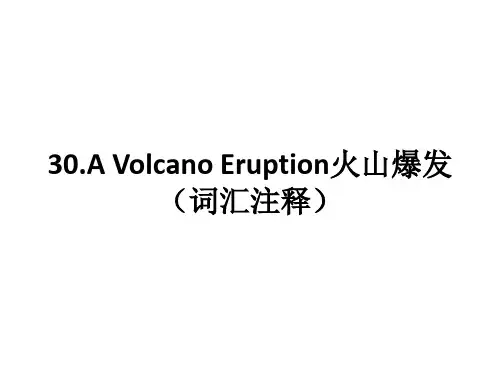
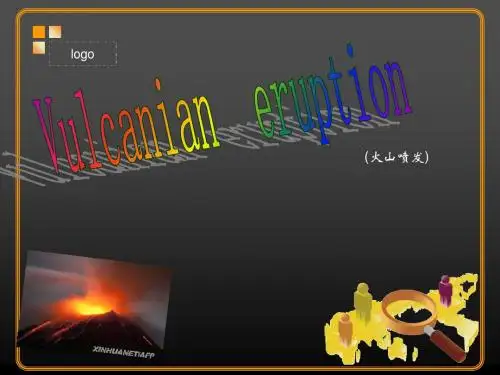
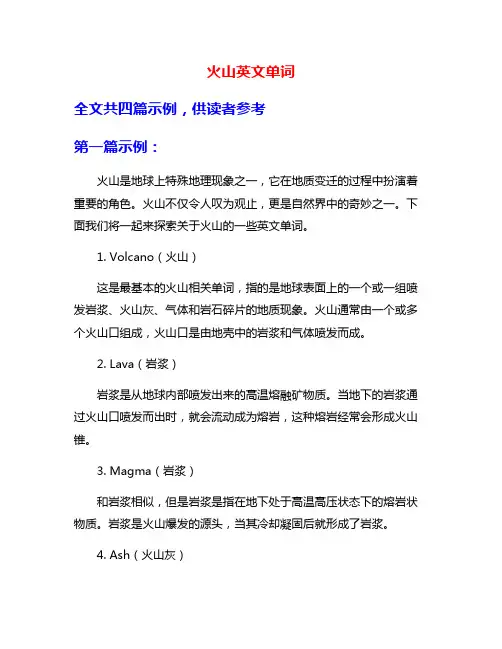
火山英文单词全文共四篇示例,供读者参考第一篇示例:火山是地球上特殊地理现象之一,它在地质变迁的过程中扮演着重要的角色。
火山不仅令人叹为观止,更是自然界中的奇妙之一。
下面我们将一起来探索关于火山的一些英文单词。
1. Volcano(火山)这是最基本的火山相关单词,指的是地球表面上的一个或一组喷发岩浆、火山灰、气体和岩石碎片的地质现象。
火山通常由一个或多个火山口组成,火山口是由地壳中的岩浆和气体喷发而成。
2. Lava(岩浆)岩浆是从地球内部喷发出来的高温熔融矿物质。
当地下的岩浆通过火山口喷发而出时,就会流动成为熔岩,这种熔岩经常会形成火山锥。
3. Magma(岩浆)和岩浆相似,但是岩浆是指在地下处于高温高压状态下的熔岩状物质。
岩浆是火山爆发的源头,当其冷却凝固后就形成了岩浆。
4. Ash(火山灰)火山爆发时释放的碎裂岩石和火山碎屑形成的细小颗粒物称为火山灰。
火山灰是火山爆发后的主要喷发物,它对农业、交通、生态环境等都有着影响。
5. Pyroclastic Flow(火山碎屑流)火山爆发时形成的高速岩石碎屑和火山气体流动体称为火山碎屑流。
这种火山碎屑流在喷发后迅速向下流动,携带着高温的火山碎石和其他岩石碎片。
6. Volcanic Crater(火山口)火山口是火山喷发释放岩浆和火山碎屑的通道,它通常位于火山锥顶部。
火山口的大小和形状取决于火山的类型和活动程度。
7. Caldera(火山口)当火山喷发造成火山口边缘坍塌时,就会形成一个巨大的火山口,这个大型火山口称为火山口。
火山口通常呈圆形或椭圆形,周围被陡峭的边缘环绕。
8. Volcanologist(火山学家)火山学家是研究火山活动和火山地质的科学家,他们通过观测和研究火山喷发、地震、气体排放等情况,来预测火山的活动和可能的危险。
9. Volcanic Eruption(火山喷发)火山喷发是火山活动中最具破坏性和危险性的现象之一,它会释放大量的岩浆、火山灰和火山气体,对周边地区造成严重影响。
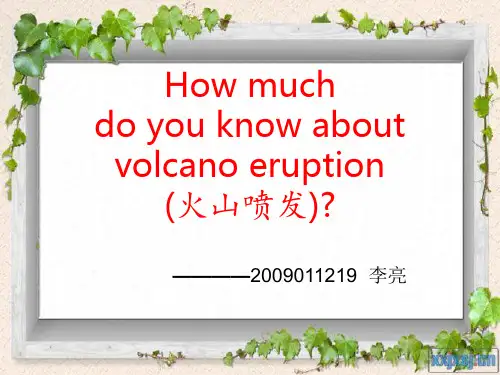

火山喷发对环境的影响摘要:看似沉默的火山,一旦爆发,就会对周边地区的环境造成严重的影响。
如果火山喷发规模庞大,甚至还会对全球的气候造成影响。
火山喷发所产生的火山灰颗粒会进入大气平流层,并在那里停留数年。
火山灰长时间阻挡照向地球的太阳射线,将会使地球气温下降。
此外,火山喷发对海底生物同样有着重大影响。
甚至于大陆形态的形成,还是地球的海洋和大气的形成,或者生命的起源,均和海底火山活动有关。
关键词:火山喷发,火山灰颗粒,生态环境,全球气候,海洋生物,恐龙灭绝,硫磺,氯气。
正文:前不久,冰岛的火山喷发对当地甚至是整个欧洲的环境造成了巨大影响,甚至有报道称而冰岛火山群的活跃活动可能影响欧洲几十年。
那么火山喷发究竟会对环境造成怎样的影响,多大的影响呢?首先,我们必须了解火山喷发(volcanic eruption)是一种奇特的地质现象,是地壳运动的一种表现形式,也是地球内部热能在地表的一种最强烈的显示。
是岩浆等喷出物在短时间内从火山口向地表的释放。
由于岩浆中含大量挥发成分,加之上覆岩层的围压,使这些挥发成分溶解在岩浆中无法溢出,当岩浆上升靠近地表时压力减小,挥发成分急剧被释放出来,于是形成火山喷发。
其具体分为裂隙式喷发和中心式喷发,上面所说的冰岛火上喷发就是属于裂隙式喷发,而且冰岛也是陆地上唯一一个存在此种喷发类型的地区。
在火山的喷发阶段,首先是气体的爆炸在火山喷发的孕育阶段,由于气体出溶和震群的发生,上覆岩石裂隙化程度增高,压力降低而岩浆体内气体出溶量不断增加,岩浆体积逐渐膨胀,密度减小,内压力增大,当内压力大大超过外部压力时,在上覆岩石的裂隙密度带发生气体的猛烈爆炸,使岩石破碎,并打开火山喷发的通道,首先将碎块喷出,相继而来的就是岩浆的喷发。
气体爆炸之后,气体以极大的喷射力将通道内的岩屑和深部岩浆喷向高空,形成了高大的喷发柱。
喷发柱在上升的过程中携带着不同粒径和密度的碎屑物,这些碎屑物依着重力的大小,分别在不同高度和不同阶段塌落。
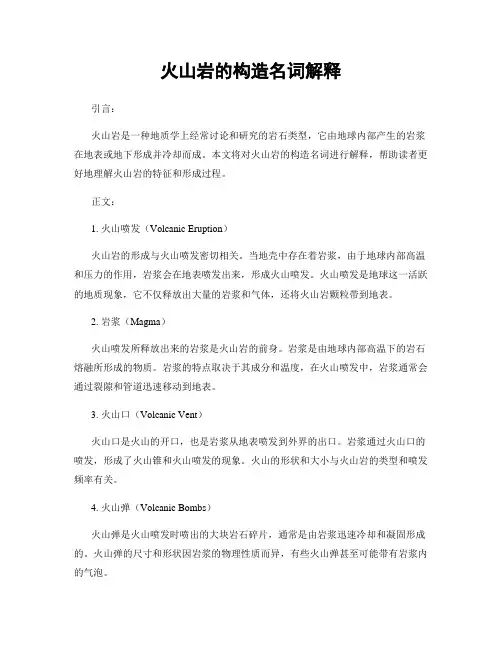
火山岩的构造名词解释引言:火山岩是一种地质学上经常讨论和研究的岩石类型,它由地球内部产生的岩浆在地表或地下形成并冷却而成。
本文将对火山岩的构造名词进行解释,帮助读者更好地理解火山岩的特征和形成过程。
正文:1. 火山喷发(Volcanic Eruption)火山岩的形成与火山喷发密切相关。
当地壳中存在着岩浆,由于地球内部高温和压力的作用,岩浆会在地表喷发出来,形成火山喷发。
火山喷发是地球这一活跃的地质现象,它不仅释放出大量的岩浆和气体,还将火山岩颗粒带到地表。
2. 岩浆(Magma)火山喷发所释放出来的岩浆是火山岩的前身。
岩浆是由地球内部高温下的岩石熔融所形成的物质。
岩浆的特点取决于其成分和温度,在火山喷发中,岩浆通常会通过裂隙和管道迅速移动到地表。
3. 火山口(Volcanic Vent)火山口是火山的开口,也是岩浆从地表喷发到外界的出口。
岩浆通过火山口的喷发,形成了火山锥和火山喷发的现象。
火山的形状和大小与火山岩的类型和喷发频率有关。
4. 火山弹(Volcanic Bombs)火山弹是火山喷发时喷出的大块岩石碎片,通常是由岩浆迅速冷却和凝固形成的。
火山弹的尺寸和形状因岩浆的物理性质而异,有些火山弹甚至可能带有岩浆内的气泡。
5. 火山灰(Volcanic Ash)火山灰是火山喷发时释放出来的细小颗粒物质。
火山灰是由岩浆迅速冷却和碾磨形成的,颗粒大小从微米到毫米不等。
火山灰可能被风吹散远离火山,甚至会遮蔽太阳光线、对环境产生影响。
6. 火山锥(Volcanic Cone)火山锥是由大量火山岩积累而成的地形特征。
随着火山喷发和岩浆的不断迸发,火山锥逐渐形成。
火山锥的形状和大小取决于岩浆的粘性和喷发频率,有些火山锥如圣海伦斯山具有典型的圆锥形。
结论:火山岩是火山喷发过程中形成的一种岩石类型。
岩浆通过火山口喷发出来后会迅速冷却,产生火山弹和火山灰等物质。
随着时间的推移,这些火山岩逐渐堆积形成火山锥,为我们提供了理解地球内部的方式。

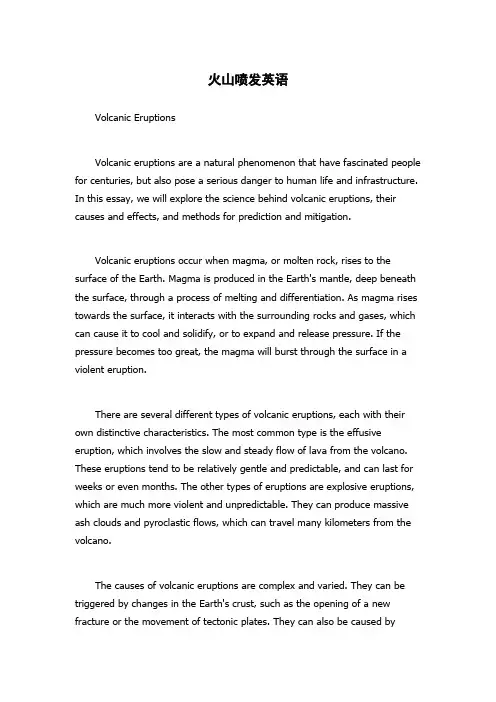
火山喷发英语Volcanic EruptionsVolcanic eruptions are a natural phenomenon that have fascinated people for centuries, but also pose a serious danger to human life and infrastructure. In this essay, we will explore the science behind volcanic eruptions, their causes and effects, and methods for prediction and mitigation.Volcanic eruptions occur when magma, or molten rock, rises to the surface of the Earth. Magma is produced in the Earth's mantle, deep beneath the surface, through a process of melting and differentiation. As magma rises towards the surface, it interacts with the surrounding rocks and gases, which can cause it to cool and solidify, or to expand and release pressure. If the pressure becomes too great, the magma will burst through the surface in a violent eruption.There are several different types of volcanic eruptions, each with their own distinctive characteristics. The most common type is the effusive eruption, which involves the slow and steady flow of lava from the volcano. These eruptions tend to be relatively gentle and predictable, and can last for weeks or even months. The other types of eruptions are explosive eruptions, which are much more violent and unpredictable. They can produce massive ash clouds and pyroclastic flows, which can travel many kilometers from the volcano.The causes of volcanic eruptions are complex and varied. They can be triggered by changes in the Earth's crust, such as the opening of a new fracture or the movement of tectonic plates. They can also be caused bychanges in the magma itself, such as the buildup of gas bubbles or the mixing of different types of magma. Some volcanic eruptions are even thought to be triggered by external factors, such as changes in the Earth's orbit or solar activity.The effects of volcanic eruptions can be both immediate and long-lasting. The immediate effects are often the most dramatic, such as the destruction of buildings, the loss of life, and the disruption of transportation and communication networks. In addition, the ash and gas produced by eruptions can cause respiratory problems and other health risks for those living near the volcano. The long-lasting effects of volcanic eruptions can be equally devastating, such as the alteration of ecosystems and the impact on local economies.Prediction and mitigation of volcanic eruptions is an important area of scientific research. Scientists use a variety of methods to monitor volcanoes, such as GPS and satellite imagery, to detect changes in the volcano's behavior. They also study the composition and behavior of magma, in order to develop models that can predict the likelihood and severity of eruptions. Finally, scientists work with local officials and emergency responders to develop plans for evacuation and disaster response.In conclusion, volcanic eruptions are a fascinating and powerful force of nature, but also pose a serious threat to human life and infrastructure. Through continued research and preparation, we can better understand and manage the risks associated with volcanic activity, and protect ourselves from these natural disasters.。
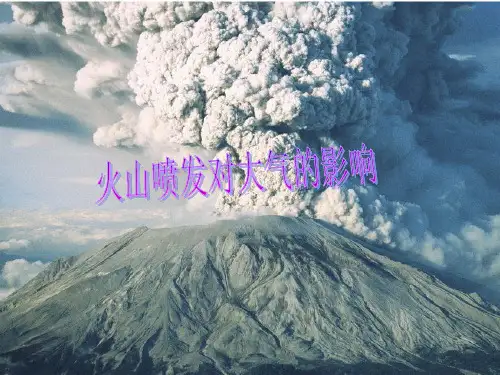
火山爆发的英文作文英文:Volcanic eruptions are among the most spectacular and terrifying natural events that can occur on our planet. When a volcano erupts, it can unleash massive amounts of ash, lava, and gases, causing destruction and chaos in its wake. The impact of a volcanic eruption can be felt for miles around, affecting not only the immediate area but also regions far beyond.I remember vividly the eruption of Mount Vesuvius in 79 AD, which buried the ancient Roman city of Pompeii beneath layers of ash and pumice. The eruption was so sudden and intense that the inhabitants of Pompeii had little time to escape, resulting in their tragic demise. This event serves as a stark reminder of the power and unpredictability of volcanic activity.In modern times, the eruption of Mount St. Helens in1980 was another significant event that captured theworld's attention. The eruption devastated surroundingareas in the state of Washington, causing widespread destruction and loss of life. The sheer force of theeruption was staggering, with ash clouds reaching as highas 80,000 feet into the atmosphere.The aftermath of a volcanic eruption can be just as devastating as the eruption itself. The ash and debris ejected during an eruption can blanket the surrounding landscape, smothering vegetation and contaminating water sources. The pyroclastic flows, fast-moving currents of hot gas and rock, can incinerate everything in their path, leaving behind a barren and desolate landscape.Despite the dangers posed by volcanic eruptions, many people choose to live near active volcanoes due to thefertile soil and breathtaking scenery they provide. However, this comes with the inherent risk of being exposed to volcanic hazards, such as lava flows, lahars, and volcanic gases. It's a delicate balance between the allure of living in such areas and the potential dangers they pose.In conclusion, volcanic eruptions are awe-inspiring displays of nature's power, capable of wreaking havoc on a massive scale. While we have made significant advancementsin monitoring and predicting volcanic activity, there isstill much to learn about these enigmatic geological phenomena. As we continue to study and understand volcanoes, we can better prepare and mitigate the impacts of future eruptions.中文:火山爆发是地球上最壮观、最可怕的自然事件之一。
英语新闻火山喷发场景English Answer:Volcanic Eruption Scene.A volcanic eruption is a spectacular and awe-inspiring natural phenomenon that can unleash immense power and beauty. As magma rises from deep within the Earth's crust, it can break through the surface and spew forth a torrent of lava, ash, and gases. The resulting eruption can cause widespread destruction and pose significant risks to nearby communities.Types of Volcanic Eruptions.Volcanic eruptions vary in size and intensity, ranging from small, localized eruptions to massive, global events. Some of the most common types of eruptions include:Hawaiian: Characterized by gentle lava flows andrelatively low explosivity.Strombolian: Produces frequent, low-energy eruptions of lava bombs and ash.Vulcanian: Ejects large volumes of ash and volcanic bombs, accompanied by thunderous explosions.Pelean: Produces a thick, viscous lava that forms a dome over the crater, which can collapse catastrophically.Plinian: The most explosive type of eruption, characterized by a towering column of ash and pumice that can reach into the stratosphere.Effects of Volcanic Eruptions.The effects of a volcanic eruption can be widespread and long-lasting. Some of the most significant impacts include:Ashfall: Ashfall can blanket the ground and damagebuildings, infrastructure, and plant life. It can also block roads and create hazardous conditions for aviation.Lava flows: Lava flows can destroy everything in their path, consuming structures, forests, and agricultural land.Pyroclastic flows: Pyroclastic flows are fast-moving clouds of hot ash and gas that can travel at speeds of hundreds of kilometers per hour. They can cause severe burns and respiratory problems.Lahars: Lahars are mudflows that form when volcanic debris mixes with water. They can be highly destructive and can travel long distances.Climate change: Large volcanic eruptions can inject massive amounts of sulfur dioxide into the atmosphere, which can lead to global cooling and acid rain.Mitigating Volcanic Risks.Volcanic eruptions are a natural hazard that cannot becompletely prevented. However, there are steps that can be taken to mitigate their risks, such as:Volcanic monitoring: Monitoring volcanic activity can provide early warning of impending eruptions, allowing for evacuation and preparation.Hazard mapping: Identifying areas at risk from volcanic hazards can help communities develop evacuation plans and land-use policies.Building codes: Enforcing strict building codes can ensure that structures are resistant to volcanic damage.Public education: Educating the public about volcanic hazards and emergency procedures is crucial for reducing risks.By understanding volcanic eruptions and taking appropriate mitigation measures, communities can minimize their vulnerability to these powerful natural events.Chinese Answer:火山喷发景象。
Volcanic Eruptions: A NaturalPhenomenonThe world we live in is full of wonders, both natural and manmade. One such natural wonder that has always fascinated and intrigued us is volcanic eruptions. These powerful displays of nature's force can be both aweinspiring and terrifying. In this essay, we will explore the phenomenon of volcanic eruptions, their causes, effects, and the ways in which they impact our lives.Volcanic eruptions are a result of the Earth's dynamic processes. The Earth's crust is made up of several tectonic plates, which are constantly moving. When these plates collide, one may be forced beneath the other, a process known as subduction. As the subducting plate sinks deeper into the Earth's mantle, it begins to melt due to the intense heat and pressure. This molten rock, known as magma, then rises towards the surface, eventually erupting through a volcano.The effects of volcanic eruptions can be both immediate and longlasting. In the short term, an eruption can cause widespread destruction, with lava flows, ash clouds, and pyroclastic flows posing a significant threat to human life and property. However, volcanic eruptions also have somepositive effects. They can enrich the soil with minerals, making it more fertile for agriculture. Additionally, theycan create new landforms, such as islands and mountains, and even contribute to the formation of new ecosystems.Volcanic eruptions also have a significant impact on the Earth's climate. The ash and gases released during aneruption can block sunlight, leading to a cooling effect onthe planet. This can have both positive and negative consequences, depending on the severity and duration of the eruption.In conclusion, volcanic eruptions are a natural phenomenon that can be both destructive and beneficial. They are a reminder of the Earth's dynamic and everchanging nature, and they continue to fascinate and intrigue us. As wecontinue to study and understand these powerful forces of nature, we can better prepare for their effects and harness their benefits.Volcanic Eruptions: A Natural PhenomenonThe world we live in is full of wonders, both natural and manmade. One such natural wonder that has always fascinated and intrigued us is volcanic eruptions. These powerfuldisplays of nature's force can be both aweinspiring and terrifying. In this essay, we will explore the phenomenon ofvolcanic eruptions, their causes, effects, and the ways in which they impact our lives.Volcanic eruptions are a result of the Earth's dynamic processes. The Earth's crust is made up of several tectonic plates, which are constantly moving. When these plates collide, one may be forced beneath the other, a process known as subduction. As the subducting plate sinks deeper into the Earth's mantle, it begins to melt due to the intense heat and pressure. This molten rock, known as magma, then rises towards the surface, eventually erupting through a volcano.The effects of volcanic eruptions can be both immediate and longlasting. In the short term, an eruption can cause widespread destruction, with lava flows, ash clouds, and pyroclastic flows posing a significant threat to human life and property. However, volcanic eruptions also have some positive effects. They can enrich the soil with minerals, making it more fertile for agriculture. Additionally, they can create new landforms, such as islands and mountains, and even contribute to the formation of new ecosystems.Volcanic eruptions also have a significant impact on the Earth's climate. The ash and gases released during an eruption can block sunlight, leading to a cooling effect on the planet. This can have both positive and negativeconsequences, depending on the severity and duration of the eruption.In conclusion, volcanic eruptions are a natural phenomenon that can be both destructive and beneficial. They are a reminder of the Earth's dynamic and everchanging nature, and they continue to fascinate and intrigue us. As wecontinue to study and understand these powerful forces of nature, we can better prepare for their effects and harness their benefits.Moreover, volcanic eruptions serve as a powerful reminder of the delicate balance of our planet's ecosystems. The destruction they cause can lead to the loss of habitats for countless species, disrupting the intricate web of life. However, they also play a crucial role in shaping the Earth's surface and creating new opportunities for life to thrive. Volcanic eruptions are a testament to the resilience and adaptability of our planet's natural systems.。
用英文写火山爆发的作文
英文回答:
Volcanic eruptions are one of the most awe-inspiring and terrifying natural events that can occur. The power and force of a volcano erupting can be truly overwhelming. I remember when Mount St. Helens erupted in 1980, it was a catastrophic event that changed the landscape of the area forever. The eruption sent plumes of ash and gas thousands of feet into the air, and the force of the explosion was equivalent to 1,600 times the power of the atomic bomb dropped on Hiroshima. The devastation was immense, and it took years for the area to recover.
中文回答:
火山爆发是自然界中最令人敬畏和可怕的事件之一。
火山喷发的力量和威力确实令人震撼。
我记得1980年圣海伦火山的爆发,那是一场灾难性的事件,永远改变了该地区的地貌。
火山喷发将灰尘
和气体喷射到数千英尺的高空,爆炸的威力相当于广岛原子弹爆炸的1600倍。
破坏是巨大的,该地区花了多年时间才得以恢复。
火山爆发的实验作文范文英文回答:Volcanic eruptions are fascinating natural phenomenathat have captivated scientists and researchers for centuries. The study of volcanic eruptions helps us understand the Earth's geology and provides important insights into the processes that shape our planet.During a volcanic eruption, molten rock called magma rises to the surface. As the magma reaches the surface, itis called lava. The eruption can be explosive or effusive, depending on the type of magma and the presence of gases. Explosive eruptions occur when the magma is thick and viscous, trapping gases and building up pressure. When the pressure becomes too great, the magma explodes, sending ash, rocks, and gases into the air. Effusive eruptions, on the other hand, occur when the magma is less viscous and gases can escape more easily. Lava flows out of the volcano in a relatively gentle manner.To recreate a volcanic eruption in a laboratory setting, scientists use a combination of chemicals and physical models. They often start by creating a model volcano using clay or other materials. Inside the model, they place a mixture of chemicals that can simulate the properties of magma. When the chemicals react, they produce gases that mimic the gases released during a volcanic eruption. The pressure from the gases causes the mixture to erupt, spewing out a lava-like substance.This experiment allows scientists to observe and study the different aspects of a volcanic eruption, such as the flow rate of lava, the formation of volcanic ash, and the release of gases. By analyzing the data collected fromthese experiments, scientists can gain a better understanding of how real volcanic eruptions occur and develop strategies to mitigate their potential hazards.中文回答:火山爆发是令人着迷的自然现象,几个世纪以来一直吸引着科学家和研究人员的注意。
火山喷发实验过程作文英语Title: The Experimental Process of Volcanic Eruption。
Introduction:Volcanic eruptions, with their immense power and geological significance, have fascinated scientists and enthusiasts alike for centuries. Understanding the mechanisms behind these eruptions is crucial for mitigating their impact on communities and ecosystems. Conducting experiments to simulate volcanic eruptions providesvaluable insights into their behavior and helps researchers refine predictive models. In this essay, I will outline the experimental process of simulating a volcanic eruption.Experimental Setup:To simulate a volcanic eruption in a laboratory setting, several key components are required. These include a chamber to contain the eruption, a heat source to mimic theintense temperatures within a volcanic magma chamber, and materials that mimic the properties of magma and volcanic gases.1. Chamber Design:The chamber used in the experiment must be able to withstand high temperatures and pressure. It should have a transparent portion for observation and monitoring purposes. Additionally, the chamber should be equipped with safety measures to prevent accidents during the experiment.2. Heat Source:A heat source, such as a furnace or heating element, is essential for generating the high temperatures necessary to simulate volcanic activity. The heat source should be capable of reaching temperatures exceeding those found in natural volcanic systems.3. Magma and Gas Substitutes:In place of real magma, researchers use materials such as molten rock analogs or synthetic substances with similar properties. These materials should have the viscosity and chemical composition comparable to natural magma. Similarly, gases released during volcanic eruptions, such as sulfur dioxide and carbon dioxide, can be simulated using compressed gases or chemical reactions.Experimental Procedure:Once the experimental setup is prepared, the process of simulating a volcanic eruption can begin. The following steps outline a typical experimental procedure:1. Chamber Preheating:Before introducing the magma substitute, the chamber is preheated to the desired temperature using the heat source. This ensures that the conditions within the chamber closely resemble those found in a volcanic magma chamber.2. Magma Introduction:The magma substitute, prepared beforehand, is carefully introduced into the chamber. The rate of magma injection and its temperature are controlled to mimic the dynamics of magma ascent within a volcanic conduit.3. Gas Injection:To simulate the release of volcanic gases, such as sulfur dioxide and water vapor, controlled amounts of gas substitutes are injected into the chamber. The interaction between magma and gases plays a crucial role in determining the style and intensity of volcanic eruptions.4. Observation and Data Collection:Throughout the experiment, researchers closely monitor the behavior of the magma and gases within the chamber. Various techniques, including high-speed cameras and spectroscopy, are employed to capture data on factors such as eruption style, gas composition, and magma rheology.5. Analysis and Interpretation:Once the experiment is complete, the gathered data is analyzed to better understand the processes involved in volcanic eruptions. Researchers compare their observations with data from real volcanic events and existing theoretical models to validate their findings.Conclusion:Simulating volcanic eruptions through laboratory experiments offers valuable insights into the complex processes occurring beneath the Earth's surface. By replicating the conditions found within volcanic systems, researchers can enhance our understanding of volcanic behavior and improve hazard assessment and mitigation efforts. As technology advances, experimental techniques will continue to evolve, leading to further discoveries in the field of volcanology.。